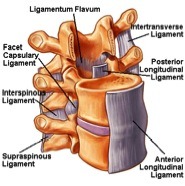Lumbar Spine Structure
- The lumbar spine is the third major region of the spine. It is comprised of 5 vertebrae (L1 through L5), discs between each vertebra, and 5 pairs of spinal nerves.
- The natural curvature of the lumbar spine is designed to support the weight of the trunk and disperse the ground reaction forces created as we move throughout the day.
- Facet joints are formed where the vertebra above makes contact with the vertebra below. As the back is flexed, extended, rotated and side bent, these joints move in a sliding motion
Lumbar Spine Function
- There are many muscles and ligaments that attach to the lumbar spine. Ligaments act to restrict excessive movement of
 the spine. Muscles act to forward flex, rotate, and side bend the spine. Some muscles act to produce large movements, while others play an important role in postural stability.
the spine. Muscles act to forward flex, rotate, and side bend the spine. Some muscles act to produce large movements, while others play an important role in postural stability. - Discs are found between each vertebra and act as a cushion. They are comprised of a softer inside portion called the nucleus pulposus, and a fibrous outer ring known as the annulus fibrosus.
- At each vertebral level, a pair of spinal nerves exits the spinal column through an opening called the intervertebral foramen.
- These nerves supply motor and sensory information to and from the lower extremities.
Potential Sources of Back Pain
- Poor posture reverses the natural curve of the lumbar spine, causing higher loads to be placed through the area.
- Weak core muscles cause instability of the lumbar spine.
- Degenerative disc changes can be a source of pain. If the disc is bulging it may push on a nerve and cause numbness, tingling, or weakness in the leg.
- Arthritis can develop in the joints of the lumbar spine causing pain and possibly restricting movement.
- Spinal stenosis, or encroachment of the nerves in the spinal canal, can be caused by disc problems or arthritic changes.
- A spondylolisthesis occurs when one vertebra slips forward in relation to the other and can cause back pain and may produce spinal stenosis.
Tips for a Healthy Lumbar Spine
- Maintaining good posture throughout the day minimizes the stresses placed o
 n all the structures of the back. Developing good postural habits may be the single most important factor for preserving the health of the lumbar spine.
n all the structures of the back. Developing good postural habits may be the single most important factor for preserving the health of the lumbar spine. - Use safe strategies to keep your spine in a good posture when lifting objects.
- Strengthen the core muscles that provide stability and support to the lumbar spine. These include the transversus abdominus, pelvic floor, and lumbar multifidus.
At Sydney Physiotherapy Solutions our highly qualified physiotherapists specialise in the assessment, treatment and prevention of neuromusculoskeletal injuries.
Contact us today – 9252 5770
This handout was prepared by Sydney Physiotherapy Solutions and is intended as a general information service. Please note that the information provided is not intended as a substitute for advice from a registered physician or healthcare professional. If symptoms persist, please consult your doctor.

